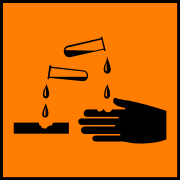|
When dealing with very large or very small numbers, it is often convenient to use logarithms, as the unwealdy numbers then become easier to use. |
|
Logarithms
A logarithm is the number to which 10 (or the base being used) must be raised to obtain the required number.
|
100 = 102 therefore log(10)100 = 2 1000 = 103 therefore log(10)100 = 3 |
The base (10 in this case) is sometimes written after the word 'log' to avoid any doubt, as many areas of science use the natural log base 'e' usually written as 'ln' (natural log). However, the assumption is often made that the word 'log' means log(10) by default.
Logarithms are used to turn either very large, or very small numbers, into numbers that are rather more convenient to handle.
|
Examples Avogadro's number 6.02 x 1023 expressed as a log(10) = 23.78 i.e. log(10) 6.02 x 1023 = 23.78 The ionic product of water = 1 x 10-14 Log(10) 1 x 10-14 = -14 |
Definition of 'p'
The letter 'p' is used to indicate the negative logarithm (base 10) of a number. This is used when the numbers are likely to be very small, so that the final value becomes conveniently sized and positive.
The letter 'p' is never a capital in this form, it stands for the word ' potential'.
|
Example The ionic product of water, Kw = 1 x 10-14 pKw is the negative log of Kw Log Kw = -14 Therefore pKw = 14 |
Definition of pH
pH is defined as the negative of the logarithm (base 10) of the hydrogen ion concentration
|
pH = -log [H+] |
|
Example At 25ºC, the hydrogen ion concentration of pure water is 1 x 10-7 mol dm-3 The logarithm of 1 x 10-7 mol dm-3 = -7 The negative of -7 = +7 Therefore the pH of pure water at 25ºC = 7 |
Definition of pOH
This is basically (no pun intended) the same as pH, but from the point of view of the OH- ions. Thus, the negative logarithm of the OH- ion concentration, [OH-], gives the pOH.
Note: at 25ºC, pH + pOH = 14. It is therefore a simple matter to obtain one from the other.
|
Example: Show that pKw = pH + pOH Kw = [H+][OH-] Kw = 1 x 10-14 [H+] = [OH-] = 1 x 10-7 pH = 7, pOH = 7 and pKw = 14 Therefore pKw = pH + pOH = 14 (at 25ºC) |
Calculations involving pH and pOH
If we are dealing with a strong acid, or base, then calculations are straightforward. It is a matter of treating the hydrogen ion concentration as the molar concentration of the acid (or base) for monobasic acids (or bases).
|
Example: Calculate the pH of 0.25 M hydrochloric acid As hydrochloric acid dissociates 100% according to the equation
Then 0.25 M hydrochloric acid gives 0.25 mol dm-3 hydrogen ions solution The pH of this solution is: pH = - log 0.25 = 0.6 |
|
Example: Calculate the pH of 0.1 mol dm-3 potassium hydroxide solution As potassium hydroxide dissociates 100% according to the equation
Then 0.1 M potassium hydroxide gives 0.1 mol dm-3 hydroxide ions solution The pOH of this solution is: pOH = - log 0.1 = 1 And as: pOH + pH = 14 therefore pH = 14 -1 = 13 |
When dealing with a weak acid (or base) the degree of dissociation into ions must be known, as given by the Ka (or pKa). This is dealt with in the next section.


